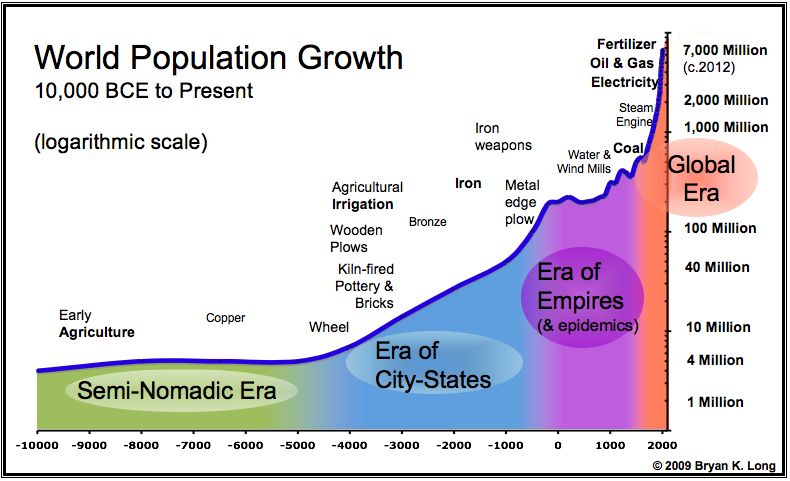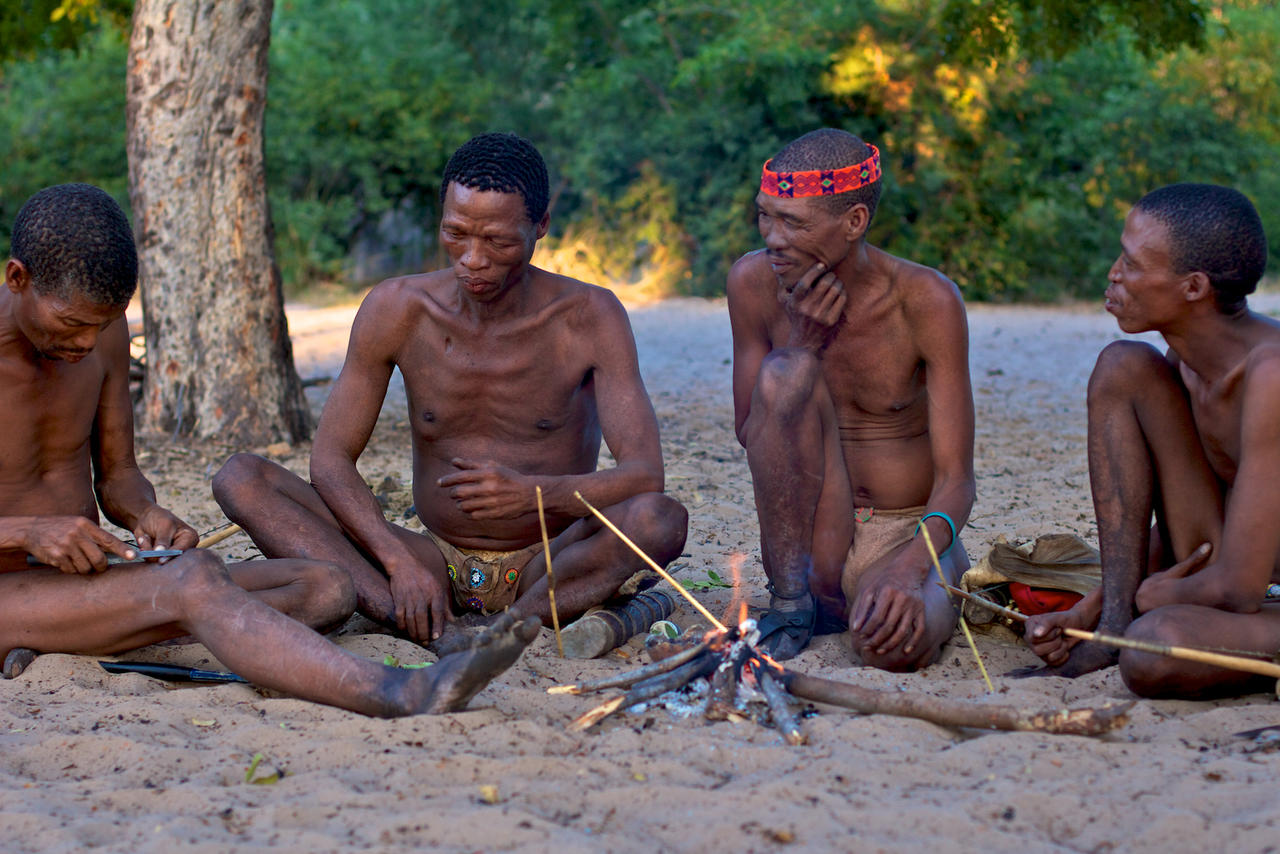Biologists often study the population dynamics of other animal species. Population sizes are described as being controlled by factors such as resource availability and prevalence of predators. Populations fluctuate in size based on the combined effects of these various influencing factors.
The world’s human population, in the last several hundred years, has been increasing exponentially and relatively undeterred. This has contributed to many contemporary problems. There is major strain on natural resources which has resulted in extensive ecological destruction. There is much social and political strife, often by way of the aforementioned environmental pressures.

Image 1: World population growth over the last 12 000 years. Population size is correlated with types of society over the time scale.
However, human populations across the globe and through time have existed in varying types of societies. One major characteristic of a society is its population size. The relationships between population dynamics and society are intricate. Does the size of a population influence the type of society in which it is found? Or conversely, does a type of society influence its population size?
One common question refers to whether human populations can exist in a more “natural” or “balanced” state, more similar to those of other animal species. And if so, what does this mean for the type of society in which such a population would have to exist?
The San peoples of Southern Africa are the last living remnants of a wide group of peoples that pre-existed even the Bantu-speaking nations of Africa, let alone the Europeans. This wide group of peoples were Stone Age hunter-gatherers who inhabited most Africa for thousands of years. The hunter-gatherer way of life which these peoples employed is still in existence today in the remote populations of San peoples.

Image 2: A group of San men in Namibia. Note the arrows (one being prepared) which are used in hunting.
This hunter-gatherer lifestyle encourages a small population size to exist. The nomadic lifestyle is certainly more easily achieved with a smaller group size and, even more importantly, a small population size allows for the ability to “live off of the land” in the gatherer fashion. Conversely, this heavy reliance upon already limited natural resources also acts as a population check, keeping the size of the population fluctuating but small.
Lifestyles such as that of the hunter-gatherer San peoples are easily romanticised. In comparison to overpopulated, stately societies around the world, they appear to conduct a lifestyle much more near a balance with their surroundings. Or at least they appear to have much less of a negative impact upon their environment.
However, many people view the modern way of life in more state-orientated societies as simply better. There are even opinions, similar to those of social Darwinism, that describe a progression over time from more basic nomadic societies to intricate and large state societies. The reality is that small mobile hunter-gatherer groups still exist today, descended from societies that have existed for thousands of years. Is that simple fact perhaps enough proof of a successful, less destructive, way of life? Ultimately, as contemporary state societies face ever-increasing problems from the socio-political and environmental arenas, time will indeed shed more light upon the situation.
Additional sources of information:
The novel Ishmael by Daniel Quinn explores types of societies, their origins, and ultimately compares them in search for a better, more ideal way of life. The book is available from the Vassar College Main Library:
http://vaslib.vassar.edu/search~S1?/aQuinn/aquinn/1%2C150%2C276%2CB/frameset&FF=aquinn+daniel&1%2C%2C3
For more information about the San peoples, their history, lifestyle and archaeology, visit South African History Online:
http://www.sahistory.org.za/people-south-africa/san
Citations:
Renfrew, Colin, and Paul G. Bahn. Archaeology essentials: theories, methods, and practice. 2nd ed. New York, NY: Thames & Hudson, 2010.
South African History Online. “The San.” http://www.sahistory.org.za/people-south-africa/san
Image 1: http://econosystemics.com/wp-content/uploads/2009/05/world-population-chart.jpg
Image 2: https://wetu.com/ImageHandler/1280×1280/24445/Nhoma-Safari-Camp-Tented-Lodge-Resdest-Namibia-Tsumkwe-Bushmenland-BushManLife3.jpg

I like how your post challenges linear conceptions of time and development relative to different societies. You also question the value judgments many make when declaring certain societies to be “better” than others. At the same time, it’s interesting to consider how our everyday language subtly encodes the same problematic ideas that we are trying to subvert. For example, we often describe societies using the term “modern.” However, this term inherently asserts that certain societies are in some way more contemporary and up-to-date than others. Again, a hierarchy of cultures and values emerges through the indirect implications of a single word. As you note through your use of quotations, the terms “natural” and “balanced” are also equally culturally constructed as they reflect certain ideas about nature and balance reflective of only one perspective. As a result, commonly used language with taken for granted meanings can therefore limit and even contradict what we intend to say. How then can we can talk about difference in an equitable and analytical manner? How can our vocabulary incorporate a variety of perspectives that does not privilege certain characteristics over others?
I agree completely. Language, and expressions of thoughts or ideas, is hard enough in daily life, let alone when you are trying to discuss something potentially sensitive in an analytical manner. Individuals have certain understanding of words that they, as you said, believe to be widely held. But they are often not. These understandings, and their differences, can scale from a personal view, to a community, to a region, to each side of the Atlantic (often my problem).
I think the degree of thought and care with which one needs to approach a situation/discussion depends on the nature and particularly the setting of the discussion itself. I personally benefit from a setting where slightly less consciousness is given to the choice of words in order to better convey emotive content. Additionally, I can always be challenged/questioned about a particular word or thought, and that process adds to the discussion. In a way it broadens that discussion, taking into account more perspectives and contradictions.
So, getting on to your latter thoughts, I think that a discussion that aims to incorporate a wide range of perspectives, and get a view that is as close to “all-encompassing” as possible, needs to be messy and not straightforward. More-so, it needs to be timely and patient.
Obviously certain settings are more conducive to this approach than others. Most forms of voicing ideas, perhaps only contemporarily (probably a better word than modern), tend to be quick and impersonal.
I think impersonal is a big one there. In attempts to reach a wider audience perhaps, discussions are often impersonal. Be it through an academic paper or on a Facebook newsfeed.
Image 1 is a cultural creation by those on the right side of the chart. There are still cultures that do not participate in this “global era”. A more interesting chart may be the current population sizes of semi-nomadic, city-state, empire cultures. Even flipping the chart so that the line goes down to global instead of up to it would reveal the biases inherent in it. Ending the chart where is does suggests we are at a pinnacle. I’d love some blank space on the right to speculate on what comes next.